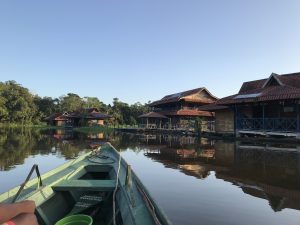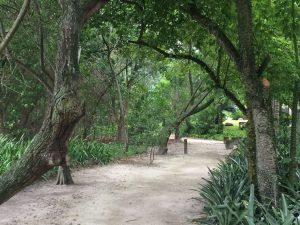In January, I led a UD study abroad program in Brazil. I took fourteen students and a TA to the Amazon for a week and then to Rio de Janeiro for the remaining two and a half weeks of January. It was a great opportunity to learn about environmental issues in Brazil and the wonderful gardens of Roberto Burle Marx and other great Brazilian landscape architects. The fourteen students came from all over the University, but several were landscape architecture and wildlife conservation majors from the College of Agriculture and Natural Resources. Most of the remaining students were environmental studies majors or science majors with concern for the environment.
Our first stop at Uacari Lodge was in the Mamiraua Reserve about one hour via motor boat from the town of Tefe on the Amazon River (or Solimoes at that location). The Reserve showed students a wonderful community model. Two naturalists, as well as local guides and support employees who rotated from the communities within the reserve staffed the floating lodge. Ecotourism dollars from the lodge provided employment for local community members and proceeds were used to buy items like a new motor so the community boat could reach a city hospital more quickly in emergencies. Students loved seeing plants and animals of the Amazon, especially, pink river dolphins (botos) and caiman swimming near our lodge. We discussed the importance of saving the Amazon ecosystem and all the valuable plants and animals that reside there, but also how important it is to allow native peoples to make a living and prosper.
In Rio de Janeiro, we had the opportunity to visit several gardens designed by Roberto Burle Marx, including his home or sitio, which includes acres of spectacular tropical plantings and several fascinating buildings reconstructed on site. Burle Marx is the landscape architect credited with beginning the native plant movement in landscape architecture. He spent several teenage years in Germany and became enamored with the tropical plants he found in hothouses in the 30’s. When he returned to Brazil, he realized those plants were Brazilian native species and began to create colorful mosaic landscape designs with those tropical plants.
Burle Marx used those native plants, not in naturalistic designs, but in painterly sweeps that create artwork on the landscape. We visited Tacaruna just north of Petropolis. This garden includes broad sweeps of colorful plants (the flowing “female” side of the landscape) and a checkerboard of different grass species (the orderly “male” side of the landscape). The roof garden on the Brazilian Re-Insurance Institute (Instituto de Resseguros do Brasil “IRB”) was recently renovated by BurleMarx, Escritorio de Paisagismo, the landscape firm owned by Burle Marx and his partner Haruyoshi Ono, now run by Isabela Ono. Burle Marx brought gardens to the tops of buildings long before it became fashionable throughout the world.
We also visited Inhotim, a public garden featuring modern art in galleries and landscape settings. Art from many of the Brazilian artists (Helio Oiticica, Clido Meireles, Vik Muniz and more) students researched for a study abroad presentation was displayed throughout the garden. Students said “It was fun to see “my” artist’s work in a garden setting”.
Penisula is a development in Barra da Tijuca built on highly disturbed land surrouding an inland lake. It was designed by Fernando Chacel and includes three important zones – mangrove swamps to cleanse the water provide biodiversity; restinga zone to protect the mangroves; and the park zone providing spaces for people to enjoy. This reconstruction was made possible through Brazilian laws requiring re-establishment of mangroves around bodies of water prior to development.
Students also enjoyed the wonderful people and culture of Brazil. If you want to learn more about this program, visit the student blog (http://sites.udel.edu/explorebrazil/). For more information about Study Abroad programs at UD, visit http://www1.udel.edu/global/studyabroad/.
If you want to learn more about horticulture in Delaware, follow my instagram (sbartonhort)
.















